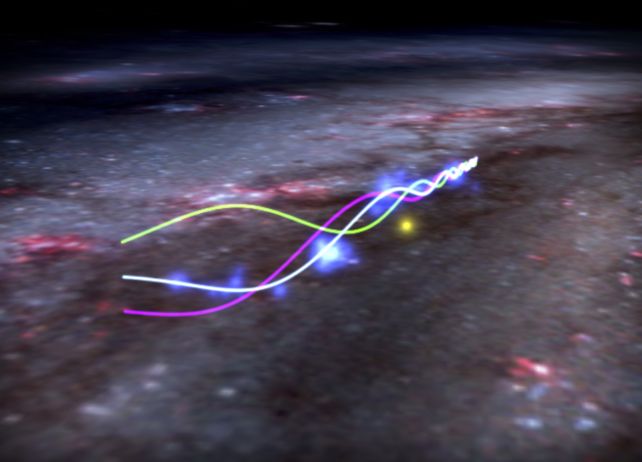A Slowly Slithering Wave-Like Structure Discovered in Our Galaxy
Looking out at the seemingly unchanging sea of stars that surrounds us, it is easy to perceive the Milky Way galaxy as static, with everything within it being fixed and unchanging.
Despite the fact that the timescales on which our galaxy moves often defy human comprehension, it is indeed in motion.
Not all of these dynamic processes are readily visible. Just a few years ago, a team of scientists discovered a massive, wave-shaped structure that stretches approximately 9,000 light-years along a spiral arm of the Milky Way, coming as close as 500 light-years from the Solar System.
Dubbed the Radcliffe Wave, this curving formation of star-forming gas is a significant find in itself, with many mysteries still surrounding it. However, a recent study led by astrophysicist Ralf Konietzka of Harvard University has shed light on one aspect: similar to numerous other objects within the Milky Way, the Radcliffe Wave is in motion.
Moreover, it is not merely orbiting around the galactic center. The Radcliffe Wave is actually oscillating as a periodic traveling wave.
Konietzka elaborates, “By observing the movement of young stars that are born within the gaseous clouds along the Radcliffe Wave, we can track the motion of their birth gas and demonstrate that the Radcliffe Wave is indeed undulating.”
Our knowledge of the three-dimensional characteristics of the Milky Way has significantly advanced in the past few years, primarily due to the Gaia project. Gaia, a spacecraft orbiting the Sun along with Earth, has been diligently surveying the Milky Way for an extended period. By utilizing parallax, it accurately determines the stars’ positions in three dimensions. Moreover, Gaia also calculates other attributes like their proper motion and velocity.
In recent years, our comprehension of the Milky Way’s three-dimensional features has greatly enhanced, largely thanks to the Gaia project. Gaia, a spacecraft that orbits the Sun alongside Earth, has been meticulously mapping the Milky Way for numerous years. Through the use of parallax, it precisely measures the stars’ positions in three dimensions. Additionally, Gaia also assesses properties such as their proper motion and velocity.

The most up-to-date map of the Milky Way has been created, detailing star positions, trajectories, and speeds. In 2018, scientists identified the Radcliffe Wave and later published their 3D map in 2020. Additional Gaia data has since provided crucial insights into the structure, allowing researchers to track baby star clusters within the wave. The undulating nature of the Radcliffe Wave resembles a cosmic serpent moving through the galaxy, influenced by normal matter gravity rather than dark matter. Supernovae within the wave likely played a role in shaping the Milky Way’s surroundings. Despite these discoveries, many questions remain unanswered about the wave’s formation, movement, and prevalence throughout the galaxy.
Astronomer Alyssa Goodman from Harvard University poses the question of what caused the displacement that resulted in the waving phenomenon we observe. She wonders if this occurrence is widespread across the galaxy or even in all galaxies. Additionally, she ponders whether it happens occasionally or consistently.
Various theories have been proposed by researchers to explain this phenomenon, ranging from supernova explosions to gravitational interactions with satellite galaxies and encounters with other large galaxies.
It is known that the Milky Way has previously merged with multiple other galaxies, and there is evidence suggesting that it is currently undergoing another collision. Recent research has also indicated that dark matter can significantly impact the overall structure of the galaxy. Therefore, there are numerous factors that could contribute to the observed waving phenomenon.
The researchers anticipate that upcoming extensive surveys of stars, dust, and gas will likely reveal more wave-like structures. By measuring their movements, valuable insights into the star formation histories and gravitational potentials of galaxies can be obtained.
Reference: Research Paper
Do not forget to share your opinion with us to provide you with the best posts !



0 Comments